
How Data Will Help Us Return to Work from COVID

(EPStudio20/Shutterstock)
We’re all feeling a bit of COVID fatigue, but thanks to the rapid creation of two vaccines (with more on the way), there is finally some light at the end of the tunnel. As much of the country prepares to return to work, smart employers will be looking to big data, machine learning, and IoT tech to help keep workers safe.
It’s doubtful that the post-COVID normal will look exactly like life did before the country started shutting down on March 16, 2020. There will likely be large swaths of the workforce that will continue to work from home.
But work from home has its limitations, and so it’s anticipated that employees in many industries will be asked to work at company locations at least some of the time. Until the novel coronavirus is completely under control, we’ll have to take precautions to minimize its chances of spreading.
Luckily, we have had 10 months to prepare for this moment, not to mention an abundance of big data and IoT technology to keep us safe.
Touchless thermometers are common tools for detecting if somebody has a fever, but it still requires people to get close. That’s one reason why contactless heat-sensing cameras, such as the one from Athena, are expected to be in demand. Athena modified its gun-detecting camera to also detect the temperature of people.
In fact, Athena’s cameras can simultaneously detect the presence of a gun and a person with COVID-19—a potentially deadly combination. “Who knew that a virus would be the new gun?” says Lisa Falzone, the company’s co-founder and CEO. “We had to be prepared.”
In November, we told you about an AI model that can detect if somebody has COVID-19 by analyzing the sound of their cough over the phone. Apparently, COVID coughs have a distinct sound that can be detecting through an algorithm. This may not be a practical method of preventing the virus from spreading at work, however.
In fact, there may be much better ways of using one’s phone to be COVID safe at work. Since the coronavirus spreads primarily via small airborne particles emitted through the nose and mouth, limiting crowds of people and enforcing a six-foot social perimeter is a good way to prevent infections. That means that tracking where employees go during work, and reminding them when they congregate too close and for too long, is another way tech can help.
One of the best ways to track where employees go during the day is through smart devices, such as smartphones and wearables, says Asanka Abeysinghe, the chief technology evangelist at WSO2, which develops software used to authenticate and identify users on corporate networks.
“If a particular meeting room is crowded, you can avoid it for safety purposes,” Abeysinghe tells Datanami. “You can plan your day…by looking at this real time data that we provide in the data layer.”
In many parts of the world–such as a Vietnamese factory, he says–employees don’t have smart phones. In these situations, it may be wise for companies to supply a wearable to the workers.
“I think that organizations are realizing that even providing a company-sponsored device is worth it because I think the most important thing we have is health at the moment,” Abeysinghe says. “How healthy is your workforce is going to play a critical role.”

Social distancing will be critical to ensuring a healthy workforce as COVID wanes (Image courtesy Nymi)
But how willing are employees to wear a wearable? According to a recent survey conducted on behalf of Nymi, a Canadian provider of wearable tech, 77% of Americans say they would use a wearable device at work “if it contributes to health, safety, and effectiveness.” In fact, about 60% of those surveyed already wear something on their device, such as a smartwatch, a fitness tracker, or a regular (i.e. dumb) wristwatch.
About one quarter of respondents said they would not wear the company’s products at work, and the primary reason was concerns about privacy and that their company may not use the data in a responsible way. That figure lowered to about 9% when it informed the users about the precautions it would take to ensure data privacy, according to Nymi, whose wearables features a fingerprint scanner that’s used for biometric authentication.
“Making employees feel safe and comfortable at work isn’t just about preventing them from catching COVID-19 or getting in an accident,” Nymi Chris Sullivan CEO said. “Companies have a responsibility to make technology decisions that will give workers full data privacy. In the case of deploying technology such as a workplace wearable, that means providing the option for employees to opt-in for the collection of this data, erase their data at any time, and more.”
Wearables are also seen as a way to staunch the impact of COVID at home. According to a recent survey by Parks Associates, 29% of consumers plan to buy at least one new health-related connected product in the next 12 months, with 25% interested in medical devices and 17% interested in wearables.
It’s anticipated that users will be able to connect some of these devices to clinical medical systems used by healthcare providers, thereby increasing the quality of remote care. While distance medicine has made big leaps over the past 10 months, healthcare providers are looking to build on those advances by figuring out how to leverage big data, AI, and IoT advances to make healthcare even better, cheaper, and faster in the future.
There’s no silver bullet to getting through the COVID crises. As we head back to work, though, being smart about who we’re around will go a long way in stemming the spread, and that’s something that tech can help us with.
Related Items:
How Data Can Help Optimize COVID-19 Vaccine Distribution
AI Model Detects Asymptomatic COVID-19 from a Cough 100% of the Time



























